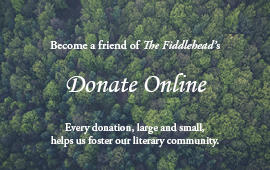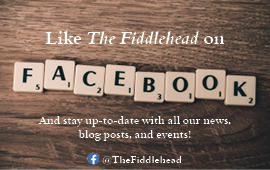
By Sarah Howden
Kate Osana Simonian has won The Fiddlehead’s 27th annual Short Fiction Prize for her story “The Press.” The following interview was conducted via email with Editorial Assistant Sarah Howden in March 2018.
----
Sarah Howden: First off, congratulations on winning The Fiddlehead’s Short Fiction Contest. To begin simply, what was the inspiration behind this piece?
Kate Osana Simonian: Thank you! I’m thrilled to have found it a home in a journal I so admire; all the better, since I’ve been working on it for about three years, on and off.
The piece was inspired by my fascination with the printing press. I was researching how Gutenberg’s press altered communications in Europe and was captivated by the idea of a technology that appears to us, now, as entirely outmoded. What’s more, presses were politically dangerous and many were operated illegally. While reading, I stumbled onto instructions for building a press. The idea of a suburban home becoming a press house and generating radical media that disrupted the banality of that space inspired the first draft, which was set in a post-apocalyptic future without electricity, in which print is the only medium.
SH: I find that when I am writing an early draft, once a certain piece of the narrative clicks into place, the rest of the story spews out of my fingers more easily than before that one piece materialized there. Is that the same for you? Was there anything in this narrative that clicked before you could keep on writing? A line? A thought?
KOS: Absolutely. This piece underwent a colossal fifteen re-drafts. A few major realizations were when I wrote the post-apocalyptic first draft and felt unmoored in place. I relocated the story to a home and then knew that I wanted the whole story to occur inside it. I then set aside the piece for a while and went through a bad break up. Afterward, all I could write were works about dependent and unhealthy relationships, and so that drama crept in. I very much wanted the story to take place between just two people.
Other massive breakthroughs were when I wrote a description of Cliff building the press and realized that his relationship to the machine was sexual: that showed me the metaphorical centrality of the press. I re-named the story “The Press”, which, through word play, led me to meditate on pressure and depression. I realized that the major inciting incident could be Petra’s depression; that writing part flowed very naturally, because I have suffered from depression myself. Another breakthrough moment was when I described Petra carving violent images. That was a surprise, but one that felt true: a small-batch, locally-produced terror, not unlike that of depression, or the terror of watching a family member succumb to it. After that, I just had to figure out how Cliff would react and try to go back and inject more tension into what can feel, at times, like a suffocating narrative.
That said, it’s somewhat difficult to pinpoint moments of breakthrough, because the story was an analysis of my own passivity and co-dependence. I often wasn’t even aware of what I was writing until it was in there and someone else commented on it. That has not been my experience with other stories.
SH: Something that I love about this piece is the incredible depth of various aspects of the story and its characters. Petra’s name is perfectly selected and has so much versatility (“Pet” and “Petra-fication” are my favourites). Cliff’s profession as a History Professor comes into play throughout, but most strongly at the end. The title has obvious connections to the subject of the story, but also literally fits into the word “depression” and connotes the physical, dull, pressing feeling of the apathy and sadness that Petra feels in the beginning of the story. There is such a richness to the themes, it’s like biting into a brownie, but then there are also so many layers that can be peeled back and compact so perfectly together, like a croissant (please excuse my cheap similes, but I am very hungry at the moment). At what step in the writing process do these aspects come together for you? Do you sprinkle them in as you go through drafts, or does most of it come during that initial spark of writing?
KOS: I appreciate you saying this. It is clear that you are a writer yourself.
No, I am not cognizant enough to come up with such thematic overlaps out of the gate, and nor do I realize that they are there until I am far into the revision process. My lack of awareness was even greater that usual when writing this piece, because there were things about the characters that I didn’t want to acknowledge, such as how unhealthy their relationship is, how unattractive and desperate Cliff’s attempts to keep things going are, how selfish Cliff’s attempt to “help” Petra by building a press really is, the anger that both parties feel for the other, and so on. In many ways, though, the torturous process of figuring out how I felt made this one of my most psychologically nuanced pieces to date.
To return to your question, most of the doubling is discovered after I’ve grasped the thematic elements, and I go back looking for things to amp up. Working the multivalence of language is a technique that I have learned from my poet friends. For instance, in every story, I always have a distinct name in mind for each character. I don’t question the name while writing, but it soon becomes clear why I have selected that aptronym. And all the better if I can spin off nicknames and double meanings that amplify the complexity of the character who owns it.
SH: Much of the tension in the story is driven by the dynamic between Cliff and Petra. In the beginning, we read that Cliff possessed the desire to “will his wife out of her depression,” but ultimately, “he was only the sort of husband who hovered anxiously and made her meals that she let spoil.” Not only does this line effectively illuminate Cliff’s underwhelming effort, it also illustrates to readers that he tolerates Petra’s behavior, even when it is potentially insulting to him. Over the course of the story, as Petra moves out of her depressive state, jumping into a much more manic lifestyle, Cliff’s passivity never changes. The ending solidifies his subordination. I think that this aspect of the story really speaks to how confusing it is to see someone who you love and someone who, in some way, depends on you, go through various mental health crises. Does the end of the story represent Cliff’s failings, or does it challenge societal expectations of what is deemed “normal” or acceptable? Does it do both?
KOS: This is a truly insightful question. Yikes! Can we start workshopping together?
To a degree, Cliff’s whole issue is his passivity, but he’s doing the best he can in an impossible situation and is a fairly active (if somewhat useless) aide. I wanted it to be unclear to the reader whether Cliff was helpless in the face of his overwhelming love for Petra, or whether this love was an excuse for his bailing on life. But my experience of being in a co-dependent relationship is that you start to get drawn into your partner’s version of reality, or it feels like an act of disloyalty to insist that your partner is out of step with reality and that you are in sync with it. Mental illness has a relativizing effect on the victim and those close to them. So I guess I didn’t want the story to choose between Cliff as moral hero or Cliff as cowardly enabler, so much as to ride between these poles.
As for whether the ending represents Cliff’s failings or challenges societal expectations, this is tricky. I see the end as a triumph of Cliff’s unhealthy love for Petra. But to me at least, it is a triumphant failure. Not just because love is a better (and more difficult) thing to feel than judgement, but because both these characters are so crushed by their stultifying lives, illnesses, and codependence, that this is the kind of triumph that they can have. The only path left for their love is a frightened and criminal one. And I do think that that’s a function of our society.
Finally, for me love is at worst a shared delusion, at best a pact between two people to form an imagined alterative reality. In that sense, monogamous love is anti-social. Or it at least it sets up a separate value system that can compete with larger societal obligations. Certainly, Cliff chooses love over social obligation. Whether that is a victory or failure is up to the reader.
SH: Throughout the story, you write some impressive lines regarding the concept of “History.” Cliff often looks for wisdom from the subject in which he has studied and taught for a large part of his life. What is your own connection to the subject of history? I feel like you have made some profound statements about it and would love to hear more!
KOS: Oh dear. Some of those lines were meant to gently ironize Cliff. But yes, I have always been interested in history, which is essentially a story in the past tense that we try to learn from. In that way, history is resembles certain classics of literary fiction and even the way we store key personal memories.
I’m also interested in the histories we build for our partners and relationships. Then there is the sort of essentialistic and deterministic nature of the historical mindset, as opposed to a more melioristic and unfixed one. Having a character whose psyche is informed by their job is not new, but the historian that is Cliff illuminates his backward facing personality quite directly.
I am a big fan of Marcel Proust to boot. Proust says (and I paraphrase), that the only paradises that exist are the ones that we have lost. By which he means (I think), that time beautifies recollection and gives it a mythic edge that the present does not possess. If beauty is tied to the perception of its loss, that explains why we fetishize both past civilizations and relationships.
SH: Something that made this piece balanced was the apt frequency of some witty, light-hearted remarks that developed Cliff’s character. Without these moments of comedic relief, I think the tone of the piece could have spiraled downwards to a place that would be a touch too dark. How do you go about feeling this balance out?
KOS: This is a great question. On a purely pragmatic level, I do inject moments of humor to illuminate the dark path my narratives take. I want readers to stick with me.
But life, as I see it, blends the comedic and the tragic, and I find the classical separation of styles to be deeply artificial. I write stories in which characters have horrendous illnesses and suffer great misfortunes, and in spite of, or perhaps because of them, use levity as a defensive mechanism.
I also think, however, that all concise and considered writing has much in common with the structure of the joke. Certainly, writing and comedy use artful repetition, condensation, the contrapunt. Because of this, no matter what I write I scatter somewhat flip sketches throughout to to concisely communicate things. I consider a piece a failure if it doesn’t have sentences that end with a punch (or punch-line), that neatly captures the bittersweet absurdity of small instants. Fiction is, at its most basic level, is entertainment. And to accurately and observantly feed the reader back something they have often seen but never articulated, brings to them a relief rather like laughing.
SH: Can you list some of the writers who you look to for motivation, inspiration, entertainment? Perhaps some from Australia?
KOS: There are so many wonderful authors to read. For inspiration I look at people writing colossally complex modernist and postmodernist works, including Marcel Proust, James Joyce, David Foster-Wallace, Virginia Woolf, Thomas Mann, Thomas Pynchon, Don DeLillo, and William Faulkner. These writers fill me with awe and remind me of what can be accomplished with words.
For motivation, I look to bad-ass female writers and writers of color, speaking from places of discomfort and marginalization. They remind me that my perspective has not yet been written (or written enough) and make me feel that my writing is necessary. I think of Claire Vaye Watkins, Kristin Dombeck, Leslie Jamison, Mary Gaitskill, Susan Minot, Maggie Nelson, and bell hooks.
Australia has some fantastic writers (and critics). I love the work of Shirley Hazzard. A fantastic indigenous futurist writer engaging with environmental questions is Alexis Wright. For feminist writings with an accessible flavor, see anything by Sara Ahmed.
SH: What’s next for you? When/where can we see more of your writing?
KOS: I’m finishing up my PhD at Texas Tech and trying to close out my novel in stories, Australialand, by the end of the year. Then I’m starting work on a work of historical fiction based on my great-grandfather’s time working on the Berlin-Baghdad railway during the Armenian Genocide of 1915. If you want to keep abreast of my publications in the meantime, check me out at katesimonian.com, or follow me on Twitter @kate_o_simonian.
----
Kate Osana Simonian is an Armenian-Australian writer, hailing from Sydney. She's on a Presidential Fellowship at Texas Tech, where she is completing a Creative Writing PhD and a linked story collection entitled Australialand. Her work has been published by the Kenyon Review Online, Ninth Letter, Chicago Tribune, and Best Australian Stories.











Add new comment